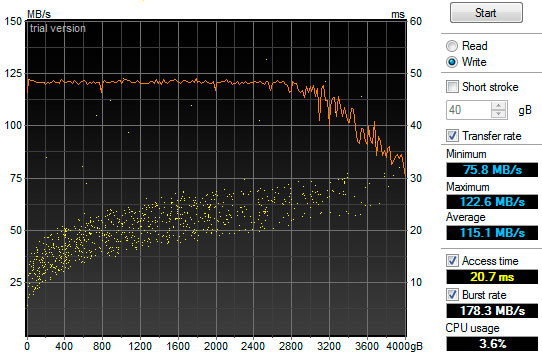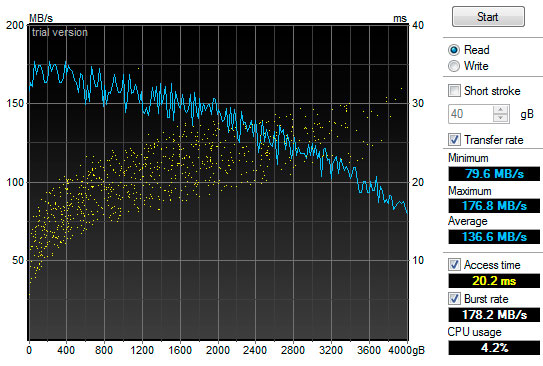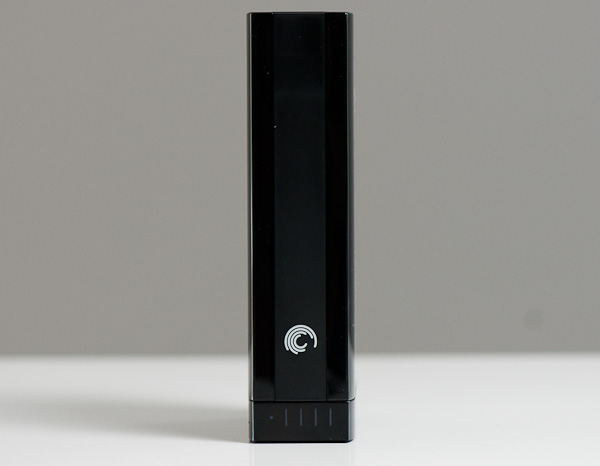Seagate's GoFlex Desk 4TB External HDD Review
by Anand Lal Shimpi on September 10, 2011 9:27 PM EST- Posted in
- Storage
- Seagate
- GoFlex Desk
- 4TB
Performance
There's no point in looking at USB 2.0 performance since all drives there are limited to under 40MB/s thanks to the speed of the interface. Over USB 3.0 however we're able to talk to the drive at much closer to its native performance:
| Windows 7 Performance Comparison | |||||
| Seagate GoFlex Desk 4TB (USB 3.0) | Seagate GoFlex Desk 3TB (USB 3.0) | ||||
| Sequential Read | 174.6 MB/s | 151.9 MB/s | |||
| Sequential Write | 137.2 MB/s | 151.2 MB/s | |||
| Random Read | 0.21 MB/s | 0.30 MB/s | |||
| Random Write | 1.14 MB/s | 0.93 MB/s | |||
Sequential read speeds are very high over USB 3.0 at 174.6MB/s. Oddly enough sequential write speeds are noticeably lower, perhaps a limitation introduced by the USB 3.0 controller inside the GoFlex dock. Max sequential write speed is lower than last year's 3TB model while read performance is improved.
Random performance is also a mixed bag. We got better random write performance but slightly lower random read performance than last year's 3TB model.
We turned to HD Tune once again to plot out performance vs. logical block address. Last year we had a somewhat odd graphs from the 3TB drive where performance dropped down to 16MB/s as we wrote to the inner most tracks of the platters. The 4TB solution doesn't have that problem but it does exhibit its own strange behavior:

Write performance remains relatively flat over the majority of the LBA range of the drive. Performance should decrease almost linearly but instead we get consistent performance across the first ~3TB of the drive. It's only in the last 1TB that performance falls down to 75.8MB/s. As I mentioned before, I suspect we may be bottlenecked writing to the GoFlex's USB 3.0 controller which results in this behavior.

Read performance is both higher and linear, indicating once again this issue seems to only limit write speed.
If you're migrating from a 3TB GoFlex Desk, do expect to see a tangible decrease in write speed but once you've got your data on the drive expect to be able to read it back faster.
Final Words
As the world becomes more mobile, external storage becomes even more important. Having moved to a notebook-as-a-desktop usage model myself, I completely understand the need for high capacity external drives.
Seagate is certainly pushing the envelope when it comes to capacity with the GoFlex Desk. Just a few years ago I had to build a file server with multiple drives to reach 4TB and today Seagate is delivering it in a small, single drive enclosure. If you need a ton of storage in a relatively compact space, the 4TB GoFlex Desk gets the job done.
The usual caveats apply however. There's always a price premium for these high capacity external drives, although Seagate is only charging an extra $50 for the 4TB version compared to the 3TB model. If you wanted to buy a standalone drives however you could easily buy two 2TB HDDs for less than half the cost of this 4TB external drive. Granted there is the convenience of having an all-in-one package with a single drive but you're almost always better off financially buying internal drives and sticking them in a cheap chassis. Then there's the problem of finding a good way to back up 4TB worth of data.
Finally there's the issue of cooling. If you're going to be constantly reading/writing terabytes of data from/to the GoFlex Desk then you'll want to look elsewhere. Seagate's modified chassis does keep the drive cooler than its predecessor but it's just not designed for extended heavy use. Google's study on hard drive reliability showed that average temperatures above 45C corresponded with an increase in failure rate, particularly for drives that had been running for 3 or more years.
I suspect most users of the GoFlex Desk will be fine however. Moving a couple hundred GBs here or there never resulted in any dangerously high temperatures. Given that this isn't an enterprise drive, I wouldn't expect most users to continuously write 1TB to the drive with any sort of regularity.











34 Comments
View All Comments
mfenn - Saturday, September 10, 2011 - link
We see the USB 3.0 performance and a lot of speculation about the limitations of the controller, so let's rip it apart and find out how it performs on its native interface!Zoomer - Sunday, September 11, 2011 - link
Agreed, that's all the product is good for anyway, assuming the drive inside is reasonable.dingetje - Sunday, September 11, 2011 - link
too big, too hot, too expensiveso no thanks, Seagate.
TypeS - Sunday, September 11, 2011 - link
Two platter 2GB drives huh.... you travel to future from the nineties?dingetje - Sunday, September 11, 2011 - link
lol..TB *cough*GeorgeH - Sunday, September 11, 2011 - link
I know I did. Kind of a cool decade, but it sure took awhile to travel through - almost 10 years, IIRC. ;)Impulses - Sunday, September 11, 2011 - link
Why don't Seagate/WD ever make these enclosures out of aluminum? Wouldn't that conduct heat away better?TypeS - Sunday, September 11, 2011 - link
Plastic is cheaper. They are a profit-making company after all.Watwatwat - Sunday, September 11, 2011 - link
Doesn't even need to be that, simply more vent holes would do. In any case these cases are almost never just plastic, sometimes there is plenty of metal inside, more than enough for good heat sinking if it were properly designed.MrSpadge - Sunday, September 11, 2011 - link
The profit margins are really tight on these 4 TB drives..MrS